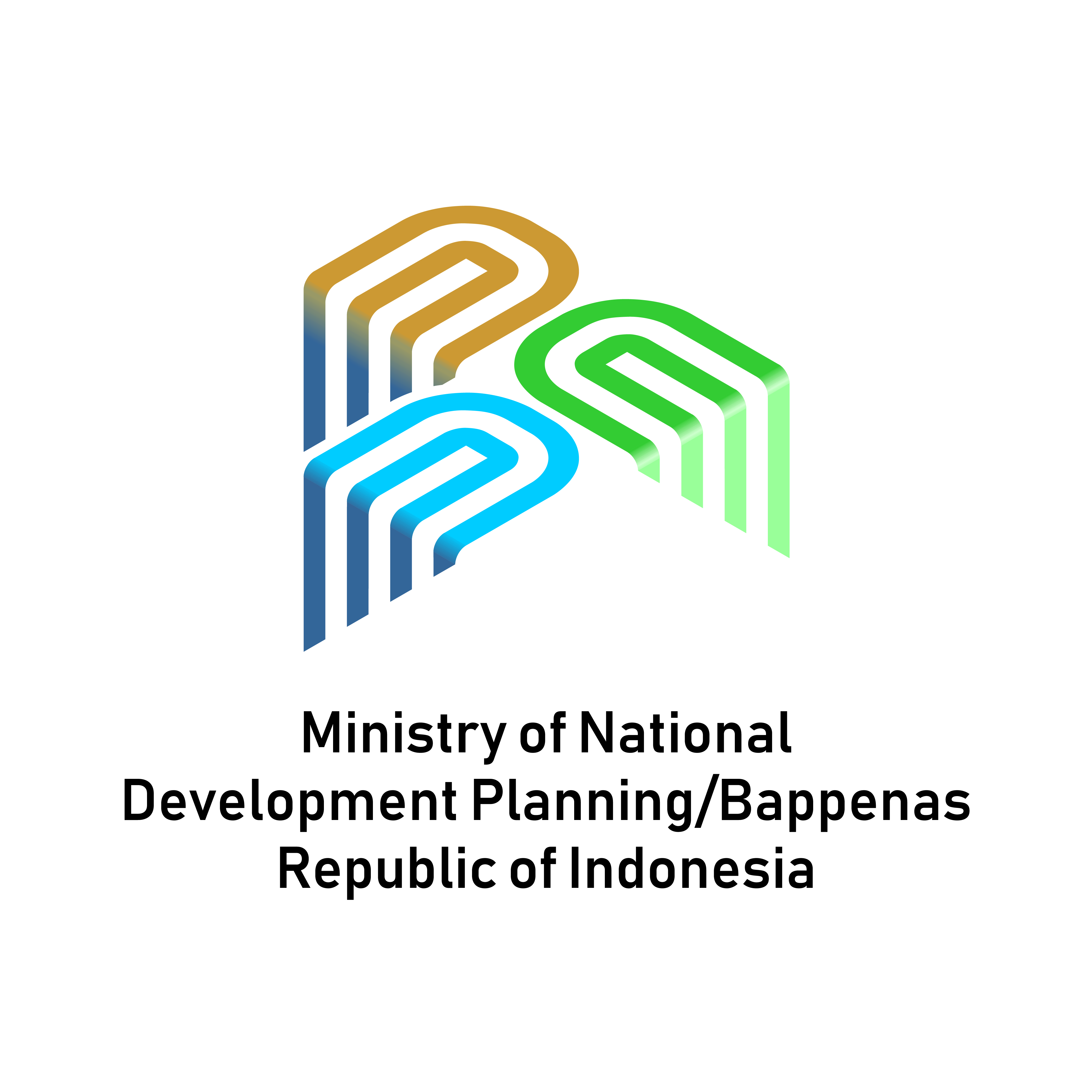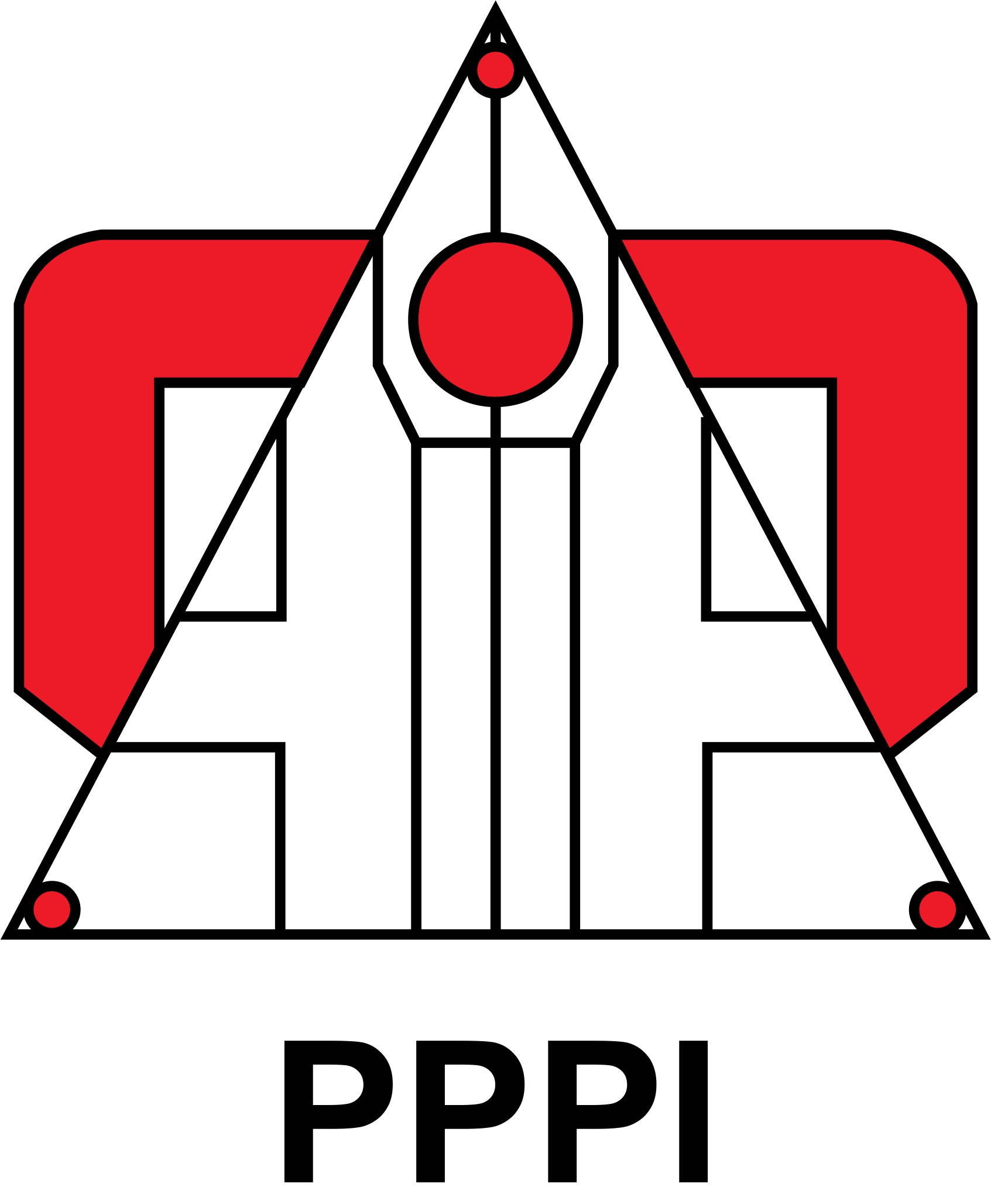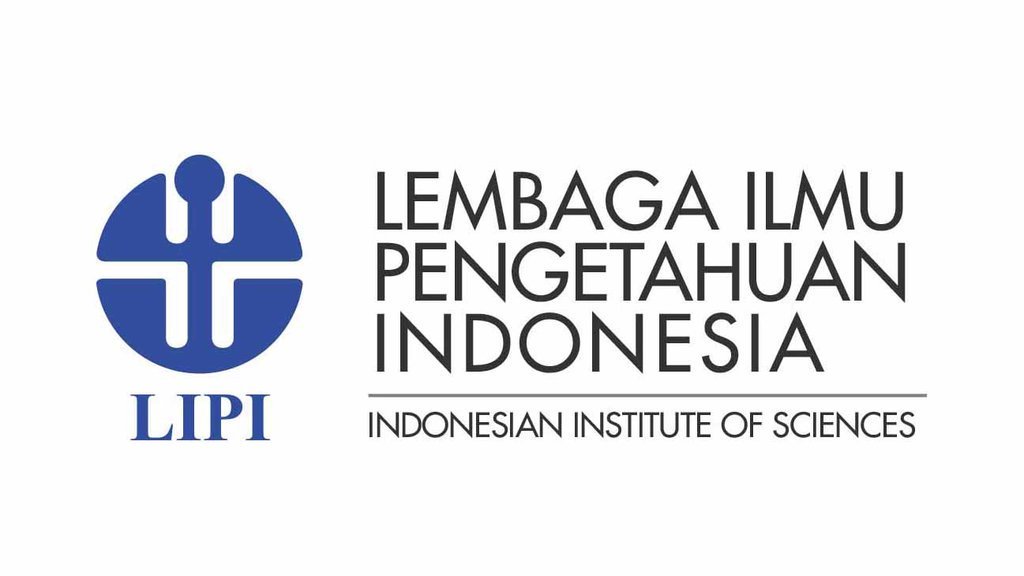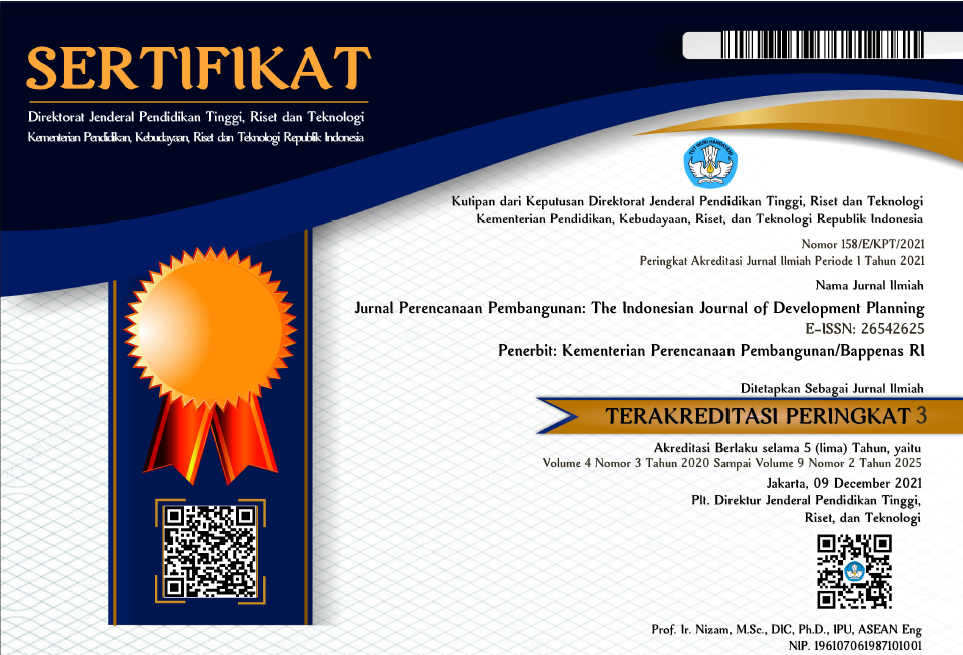Drinking Water Development Plan Evaluation Through Transfer to Regions Fund
DOI:
https://doi.org/10.36574/jpp.v8i3.484Keywords:
drinking water, SAF, regional development, RGWPAbstract
Drinking water is one of the national development targets of both central and regional governments. Given the importance of the drinking water sector for the community, the local government allocates funding for drinking water through the Local Government Budget mechanism with all of its limitations. One of the central government's supports for drinking water is the transfer of funds to the regions within the scope of the national priority section of the Government Work Plan (GWP). The drinking water development planning is interesting to review from two planning sides: the central government through the Government Work Plan (GWP) and the regional government through the Regional Government Work Plan (RGWP). This study aims at the level of linkage of transfer fund planning related to national priorities, namely the Special Allocation Fund (SAF) for Physical Assignments, in a top-down and bottom-up manner. The method used is a mixed method approach through planning gap analysis based on literature studies on central-regional planning documents and questionnaires. On a more specific side, Central Java Province was chosen as the recipient of the largest SAF allocation in the drinking water sector. The analysis result state that Central Java has not fully allocated a budget for the issue of rural drinking water supply in its regional development planning. The priority for drinking water development in this province has not been stated correctly in the RGWP. Meanwhile, the results of the questionnaire indicated that the implementation of SAF in Central Java which the central government funded was considered to have a positive impact on improving drinking water services and infrastructure as part of the minimum service standard (MSS). The development of drinking water with the SAF budget in Central Java is carried out with good supervision and sufficient funding so that output and realization can occur according to the target. From a planning perspective (gap analysis), the suitability of the SAF menu with the Regional Government Work Plan for drinking water issues is 60 percent.
Downloads
References
Daniel, D., Prawira, J., Al Djono, T. P., Subandriyo, S., Rezagama, A., & Purwanto, A. (2021). A System Dynamics Model of the Community-Based Rural Drinking Water Supply Program (PAMSIMAS) in Indonesia. Water, 13(4), 507. doi:10.3390/w13040507.
GoI. (2019a). Central Java Provincial Regulation Number 5 of 2019 concerning the Central Java Province Regional Medium-Term Development Plan 2018-2023 (Peraturan Daerah Provinsi Jawa Tengah Nomor 5 Tahun 2019 tentang Rencana Pembangunan Jangka Menengah Daerah Provinsi Jawa Tengah 2018-2023). Jakarta: Government of Indonesia.
GoI. (2019b). Ministry of Public Works and Public Housing's SAF E-Monitoring (E-Monitoring DAK Kementerian PUPR). Jakarta: Government of Indonesia.
GoI. (2018a). Presidential Regulation 141 of 2018 concerning Physical SAF Guidelines (Peraturan Presiden 141 Tahun 2018 tentang Petunjuk DAK Fisik). Jakarta: Government of Indonesia.
GoI. (2018b). Presidential Regulation 72 of 2018 concerning Government Work Plan 2019 (Peraturan Presiden Nomor 72 Tahun 2018 tentang Rencana Kerja Pemerintah Tahun 2019). Jakarta: Government of Indonesia.
GoI. (2018c). Governor of Central Java Regulation Number 66 of 2018 concerning the Regional Government Work Plan (RGWP) of Central Java Province in 2019 (Peraturan Gubernur Jawa Tengah Nomor 66 Tahun 2018 tentang Rencana Kerja Pemerintah Daerah Provinsi Jawa Tengah Tahun 2019). Jakarta: Government of Indonesia.
GoI. (2018d). Demak Regent Regulation Number 50 of 2018 concerning the Demak Regency Regional Government Work Plan (RGWP) 2019 (Peraturan Bupati Demak Nomor 50Tahun 2018 tentang Rencana Kerja Pemerintah Daerah Kabupaten Demak Tahun 2019. Jakarta: Government of Indonesia.
GoI. (2014). Law 23 of 2014 concerning Regional Government (Undang-Undang Nomor 23 Tahun 2014 tentang Pemerintahan Daerah). Jakarta: Government of Indonesia.
Howey, K., & Grealy, L. (2021). Drinking water security: the neglected dimension of Australian water reform. Australasian Journal of Water Resources, 25(2), 111–120. doi:10.1080/13241583.2021.1917098.
Ibrahim, F.N.A., & Abdul, I. (2019). Effect of Special Allocation Funds (DAK), Capital Expenditures, and Investment on Economic Growth in the Sulawesi Region. Jambura Equilibrium Journal Vol 1. No 1. January 2019. DOI: https://doi.org/10.37479/jej.v1i1.2000.
Jury, W. A., & Vaux, H. J. (2007). The Emerging Global Water Crisis: Managing Scarcity and Conflict Between Water Users. Advances in Agronomy, 1–76. doi:10.1016/s0065-2113(07)95001-4 .
Pagano, A., Giordano, R., & Vurro, M. (2021). A Decision Support System Based on AHP for Ranking Strategies to Manage Emergencies on Drinking Water Supply Systems. Water Resources Management, 35(2), 613–628. doi:10.1007/s11269-020-02741-y.
Pambudi, A.S. (2022). Synchronization of Top-Down and Bottom-Up Development Planning Concerning Water Supply Development: A Case Study in Central Java Province (Sinkronisasi Perencanaan Pembangunan Top-Down Dan Bottom-Up Tentang Pembangunan Air Minum: Studi Kasus Di Provinsi Jawa Tengah). Jurnal Ilmiah Wahana Bhakti Praja. 12 (1), 23-43. DOI: https://10.33701/jiwbp.v12i1.2335.
Pambudi, A.S. (2021). Overview and Evaluation of Indonesia’s Water Resources Management Policies for Food Security. Indonesian Journal of Applied Environmental Studies (InJAST), 2(2), 84-93. DOI: 10.33751/injast.v2i2.3586.
Pambudi, A.S., Moersidik, S.S., Karuniasa, M. (2021a). Distribution Analysis of Surface Runoff in the Lesti Sub-Watershed as a Consideration for Upstream Conservation of the Brantas Watershed (Analisis Sebaran Limpasan Permukaan pada Sub DAS Lesti Sebagai Pertimbangan Konservasi Hulu DAS Brantas). Jurnal Teknik Pengairan. 12 (2), 24 – 35. https://doi.org/10.21776/ub.pengairan.2021.012.02.03.
Pambudi, A. S., Deni, Hidayati, S., Putri, D. A. C., & Wibowo, A. D. C. (2021b). Special Allocation Fund (DAK) For Education Sector: A Development Evaluation Perspective Of Fiscal Year 2019. Jurnal Ekonomi dan Pembangunan, 29(1), 41-58. https://doi.org/10.14203/JEP.29.1.2021.41-58.
Pambudi, A. S. (2020). Analysis of The Relationship between Human Development Index toward Environmental Quality Index in South Sulawesi. MONAS Jurnal Inovasi Aparatur, 2 (1), 109-123. e-ISSN: 2656-0194.
Purwanto, E. W. (2020). Construction of Clean Water Access After the Covid-19 Crisis (Pembangunan Akses Air Bersih Pasca Krisis Covid-19). Jurnal Perencanaan Pembangunan: The Indonesian Journal of Development Planning, 4(2), 207-214. https://doi.org/10.36574/jpp.v4i2.111.
Regional Autonomy Directorate. (2019). Presentation of the Development of the Special Allocation Fund for Central Java Province in 2019 (Paparan Perkembangan Dana Alokasi Khusus Provinsi Jawa Tengah Tahun 2019). Jakarta: Regional Autonomy Directorate Bappenas.
Rifai, B. (2017). Implementation of Government and Private Cooperation in Infrastructure Development for the Drinking Water Sector in Indonesia (Implementasi Kerja Sama Pemerintah Dan Swasta Dalam Pembangunan Infrastruktur Sektor Air Minum Di Indonesia). Jurnal Ekonomi Dan Pembangunan 22 (2), 165-81. https://doi.org/10.14203/JEP.22.2.2014.165-181.
Rofiana, V. (2015). Policy Implementation of PAMSIMAS Program (Implementasi Kebijakan Program PAMSIMAS). The Indonesian Journal of Public Administration (IJPA), 1(2), 171 - 200. DOI: https://doi.org/10.52447/ijpa.v1i2.273.
Rudra, A., & Chattopadhyay, A. (2018). Environmental quality in India: Application of environmental Kuznets curve and Sustainable Human Development Index. Environmental Quality Management, 27(4), 29–38. doi:10.1002/tqem.21546 .
Sulaeman, A. S., & Andriyanto, N. (2021). Optimizing the Management of Special Allocation Funds (SAF) to Encourage Regional Development Growth in Indonesia (Optimalisasi Pengelolaan Dana Alokasi Khusus (DAK) Untuk Mendorong Pertumbuhan Pembangunan Daerah Di Indonesia). Jurnal Aplikasi Akuntansi, 5(2), 175–200. https://doi.org/10.29303/jaa.v5i2.99.
Yaqin, U.A & Herwanti, T. (2019). Problems Analysis in the Management of General Allocation Funds and Special Allocation Funds in Regional Governments (Analisis Permasalahan Pengelolaan Dana Alokasi Umum dan Dana Alokasi Khusus pada Pemerintah Daerah). Akurasi: Jurnal Studi Akuntansi Dan Keuangan, 1(2), 123 - 136. https://doi.org/10.29303/akurasi.v1i2.9.
Yu, L., Liu, X., & Hua, Z. (2022). Occurrence, Distribution, and Risk Assessment of Perfluoroalkyl Acids in Drinking Water Sources from the Lower Yangtze River. Chemosphere, 287,132064. https://doi.org/10.1016/j.chemosphere.2021.132064. Jurnal Sosial dan Budaya Syar-I. Vol 7, No 6 (2020). DOI: https://doi.org/10.15408/sjsbs.v7i6.15363
Kuncoro M. (2004). Otonomi dan Pembangunan Daerah. Jakarta: Erlangga
Pambudi, A. S., & Putri, D.M.A.C. (2022). Evaluasi Dukungan DAK Fisik Bidang Pariwisata bagi Pembangunan Daerah: Studi Kasus Nasional dan Provinsi Jawa Timur. Bappenas Working Papers, 5(1), 31 - 47. https://doi.org/10.47266/bwp.v5i1.106
Pambudi, A.S. (2021a). Evaluasi On Going Dana Alokasi Khusus Fisik Bidang Pendidikan Dalam Masa Pandemi Corona Virus Disease-19 Berbasis Intelligence Media Management (IMM). Jurnal Kebijakan Pemerintahan, 4(2): 1-7.
Pambudi, A.S. (2021b). Kendala Adaptasi Pemerintah Daerah Dalam Implementasi DAK Fisik Saat Pandemi COVID-19. Jurnal Ilmiah Wahana Bhakti Praja, 11 (1): 1-17.
Pambudi, A. S. (2021c). Optimalisasi Pemanfaatan Big Data dalam Evaluasi On Going DAK Fisik Bidang Kesehatan saat Pandemi COVID-19. Bappenas Working Papers, 4(2): 201-217.
Pambudi, A.S., Deni, Hidayati, S., Putri, D.A.C., & Wibowo, A. D. C. (2021). Special Allocation Fund (DAK) for Education Sector: A Development Evaluation Perspective of Fiscal Year 2019”. Jurnal Ekonomi dan Pembangunan, 29 (1): 41-58.
Syahfitri, Y. & Wahyuni E.S. (2020). Mekanisme Penyaluran Dana Alokasi Khusus (DAK) Fisik dan Dana Desa Melalui Kantor Pelayanan Perbendaharaan Negara Dumai Pada Wilayah Bayar Kabupaten Bengkalis. Jurnal IAKP, 1(2): 74-83.
Downloads
Published
How to Cite
Issue
Section
License
Copyright (c) 2024 Jurnal Perencanaan Pembangunan: The Indonesian Journal of Development Planning

This work is licensed under a Creative Commons Attribution-NonCommercial-ShareAlike 4.0 International License.
This is an open-access article distributed under the terms of the Creative Commons Attribution-NonCommercial-ShareAlike 4.0 International License. Copyright © Kementerian PPN/Bappenas RI

















